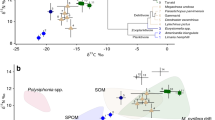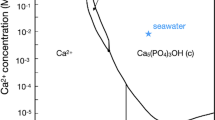Abstract
In an effort to explain the rarity of fish bones in the Great Lakes sediments, the degradation of ground fresh fish bones in microcosms containing Lake Erie sediments has been studied. The rapid build-up of phosphorus in the aqueous phase points to the great instability of the bone mineral in these sediments, while the actual analysis of the sediments shows that 10–50% of the added bone was degraded in three weeks. The decomposition rate was independent of the redox conditions of the microcosm, and was biologically mediated. Also, the incongruent dissolution of the bone apatite entailed the secondary formation of vivianite (ferrous phosphate) and other calcium and aluminocalcium phosphates. Calculations suggest that fish debris account for well over 10–20% of the P flux to the sediments in some nearshore areas. Since most of this P is quickly remineralized, the contribution of carrion to the differences in the quality of nearshore and offshore waters of the Lower Great Lakes must remain an intriguing question.
Similar content being viewed by others
References
Atlas, E. L. & Pytkowicz, R. M., 1977. Solubility behavior of apatites in seawater. Limnol. Oceanogr. 22: 290–300.
Ayyakkanu, K. & Chandramohan, D., 1971. Occurrence and distribution of phosphate solubilizing bacteria and phosphatase in marine sediments at Porto Nova. Mar. Biol. 11: 201–205.
Chien, S. H. & Black, C. A., 1975. The activity concept of phosphate-rock solubility. Soil Proc. Sci. Soc. Am. 39: 856–858.
Chiou, C. J. & Boyd, C. E., 1974. The utilization of phosphorus from muds by phytoplanktor, Scenedesmus dimorphus, and the significance of these findings to the practice of pond fertilization. Hydrobiologia 45: 345–355.
Clark, J. S., 1955. Solubility criteria for the existence of hydroxyapatite. Can. J. Chem. 33: 1696–1700.
Durbin, A. G., Nixon, S. W. & Oviatt, C. A., 1979. Effects of the spawning migration of the alewife, Alosa pseudoharengus, on freshwater ecosystems. Ecology 60: 8–17.
Gregory, T. M., Moreno, E. C. & Brown, W. E., 1970. Solubility of CaHPO4 · 2H2O in the system Ca(OH)2-H3PO4-H2O at 5, 15, 25 and 37.5°C. J. Res. natn. Bur. Stand. A74: 461–475.
Greenwood, M. R., 1970. State-Federal Lake Michigan alewife control investigation. Fish Wild. Serv. U.S. Dep. Interior, Ann Arbor, Michigan, 5 pp.
Harwood, J. E., Van Steenderen, R. A. & Kuhn, A. L., 1969. A rapid method for orthophosphate analysis at high concentrations in water. Wat. Res. 3: 417–425.
Kemp, A. L. W. & Thomas, R. L., 1975. Impact of man's activities on the chemical composition of the sediments of Lakes Ontario, Erie and Huron, Wat. Air Soil Pollut. 5: 469–490.
Kitchell, J. F., Foonce, J. F. & Tennis, P. S., 1975. Through fishes. Verb. int. Ver. Limnol. 19: 2478–2484.
Kitchell, J. F., O'Neill, R. V., Webb, D., Gallepp, G. W., Bartell, S. M., Koonce, J. F. & Ausmus, F. S., 1979. Consumer regulation of nutrient cycling. BioScience 29: 28–34.
Levinskas, G. J. & Neumann, W. F., 1955. The solubility of bone mineral. 1. Solubility studies of synthetic hydroxyapatite. J. Phys. Chem. Wash. 59: 164–168.
Moreno, E. C., Gregory, T. M. & Brown, W. E., 1968. Preparation and solubility of hydroxyapatite. J. Res. natn. Bur. Stand. A72: 773–782.
Muromtsev, G. S., 1958. The dissolving action of some root and soil microorganisms on insoluble calcium phosphates. Agrobiologiya 5: 9–14.
Nakashima, B. S. & Leggett, W. C., 1980. The role of fishes in the regulation of phosphorus available in lakes. Can. J. Fish. aquat. Sci. 37: 1540–1549.
Niewolak, S., 1971. The microbial decomposition of tribasic calcium phosphate in the Ilawa lakes. Acta hydrobiol. 13: 131–145.
Nriagu, J. O., 1976. Phosphate-clay mineral relations in soils and sediments. Can. J. Earth Sci. 13: 7.7–736.
Nriagu, J. O. & Dell, C. I., 1974. Diagenetic formation of iron phosphates in recent sediments. Am. Miner. 59: 934–946.
Richey, J. E., Perkins, M. A. & Goldman, C. R., 1975. Effects of kokanne salmon (Oncorhyncus nerka) decomposition on the ecology of a subalpine stream. J. Fish. Res. Bd Can. 32: 817–820.
Rootare, H. M., Dietz, V. R. & Carpenter, F. G., 1962. Solubility product phenomena in hydroxyapatite-water systems. J. Colloid Sci. 17: 179–206.
Sagher, A., Harris, R. F. & Armstrong, D. E., 1975. Biological availability of sediment phosphorus to microorganisms. Tech. Rep WISCWRC-75–01, Wat. Resour. Center, Univ. Wis., Madison, 5 pp.
Smith, A. N.,Posner, A. M. & Quirk, J. P., 1974. Incongruent dissolution and surface complexes of hydroxyapatite. J. Colloid Interface Sci. 48: 442–449.
Smith, E. A. H., Mayfield, C. I. & Wong, P. T. S., 1977. Colonization and decomposition of fish bone material in natural and synthetic aqueous solutions. J. Fish. Res. Bd Can. 34: 2176–2184.
Sperber, J. I., 1958. Solution of apatite by soil microorganisms producing organic acids. Austr. J. agric. Res. 9: 782–787.
Suess, E., 1981. Phosphate regeneration from sediments of the Peru continental margin by dissolution of fish debris. Geochim. cosmochim. Acta 45: 577–588.
Vallentyne, J. R., 1960. On fish remains in lacustrine sediments. Am. J. Sci. A258: 344–349.
Wier, D. R., Chien, S. H. & Black, C. A., 1971. Solubility of hydroxyapatite. Soil Sci. 3: 107–112.
Williams, J. D. H., Shear, H. & Thomas, R. L., 1980a. Availability to Scenedesmus quadricauda of different forms of phosphorus in sedimentary materials from the Great Lakes. Limnol. Oceanogr. 25: 1–11.
Williams, J. D. H., Mayer, T. & Nriagu, J. O., 1980b. Extractability of phosphorus from phosphate minerals common in soils & sediments. Soil Sci. Soc. Am. J. 44: 462–465.
Author information
Authors and Affiliations
Rights and permissions
About this article
Cite this article
Nriagu, J.O. Rapid decomposition of fish bones in Lake Erie sediments. Hydrobiologia 106, 217–222 (1983). https://doi.org/10.1007/BF00008119
Received:
Accepted:
Published:
Issue Date:
DOI: https://doi.org/10.1007/BF00008119




